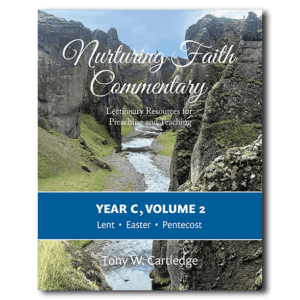
We parked on the curb and our eyes automatically pulled to our left. You couldn’t miss the chain linked fencing surrounding the soaring but now-charred tower of St. Liborious, a prominent German Catholic cathedral that had been a center of the community for families who lived in the neighborhood decades before.

(Credit: Amy Butler)
White flight emptied the church, and in 1993, it was purchased by a company who turned its sanctuary into a skate park, altar and pillars covered with colorful, intentionally placed graffiti, and ramps snaking through the soaring space once lined by pews.
But even none of that remains now because a few weeks ago, an electrical fire broke out in an adjoining building, the former rectory. Despite best efforts, the flames jumped from the rectory to the cathedral, becoming a catastrophic fire that rendered this majestic building almost gone.
The bright blue dumpster out front tells the story of what will happen next: the remaining structure will be taken apart, piece by piece, and appropriately disposed of. The land…who knows?
I was headed that day to the lot next door to the now-burned church, a piece of the neighborhood that had, until just 10 years ago, stood forlornly as an abandoned building. Once a home, it was by then just one more entry on the city’s official list of blighted properties.
It is now New Roots Urban Farm, a riotous garden with many areas of traditional gardens—rows of leafy green Swiss chard and tomatoes just starting to blossom. And here and there, you come across a chicken coop…or a new structure that will soon be a raised garden bed…or a whole corner of the garden filled to overflowing with disorderly wildflowers, sunflowers, morning glory and the like.

(Credit: Amy Butler)
Running through the gardens are children who laugh loudly and proudly announce: “I planted the tomatoes,” elderly white folks in goofy gardening hats hacking away at overgrown corners. A young white queer woman who lives down the street is just hanging out with all of these, her friends, explaining that these are her people, her neighbors. On the sidewalk is a local artist screen printing t-shirts that read: Black Farmers Matter, and as we leave, an entire bus of Black soon-to-be college students arrives to volunteer.
The master of this beautiful, chaotic three-ringed circus is Antajuan Adams, a wiry force to be reckoned with, leading people like me through the garden all the while keeping the children from tripping over things and directing workers like a master conductor evokes a symphony from an orchestra.
Antajuan speaks, always, with the urgent force of a social change agent, about this neighborhood he grew up in. He is the eldest of eight children, whose mother struggled to survive.

(Credit: Amy Butler)
He says we—all of us—live in a food apartheid, where what we eat is tightly controlled by the government and large food distribution companies. Black and brown communities especially have not been given the opportunities to learn about food apartheid. And all of us need to take hold of our own opportunities and learn to produce our own healthy food.
In the wake of the fire, though, hoses stretched through the farm broke down the greenhouse. Chemicals treating the fire sprayed all over the vegetables and sank into the soil. A lot of animals died.
Antajuan and his partner Mina feel strongly that they cannot in good conscience feed this community vegetables now tainted with unknown contaminants. They are just now beginning to think about what’s next for New Roots.
Their work is compelling and beautiful and so desperately difficult. I spent the morning in the garden, and as I pulled away, I thought about all the people I saw while I was there.
Those older white volunteers in goofy gardening hats, pulling as many as they can, to even just a little, dismantle a huge, yawning, despair-filled system.
Artists adding to the destruction with a little bit of beauty.
Neighbors who live in the neighborhood, longing to find a place they can belong.
An elderly man and his wife pulling up in their car, engine idling, windows rolled down, explaining that he grew up in that neighborhood and was visiting to reminisce.
Outspoken activists insisting that Black farmers need a voice, and this neighborhood needs healthy food.
Students learning.
People like me, looking for social entrepreneurs with enough guts to take on a problem so tangled it scares away even the most social-justice minded souls among us.
Children exclaiming with delight over the news that a new litter of bunnies was on the way, wielding paint brushes to decorate glass jars that will hold cut flowers.
All of these, and more.
I thought: everybody’s looking for something. And here they’ve found it: on a little plot of beat-up land whose soil and landscape, though bruised and battered, is filled with seeds, and people, stubbornly sending out roots, hoping that justice and goodness and nourishment and hope will be the crop that they produce.
It’s church near the corner of Hogan and N Market street.
And it’s not in the church on the corner. Instead, it’s right outside, sprouting new life right this very minute, as God always, always does.




